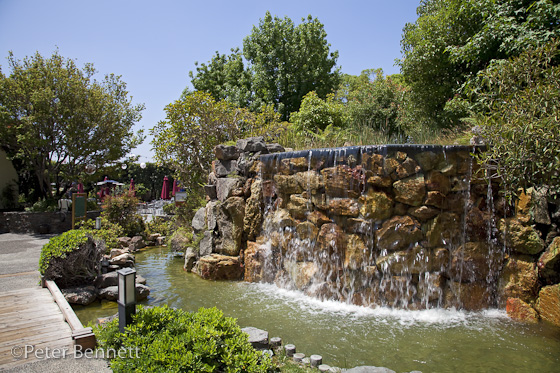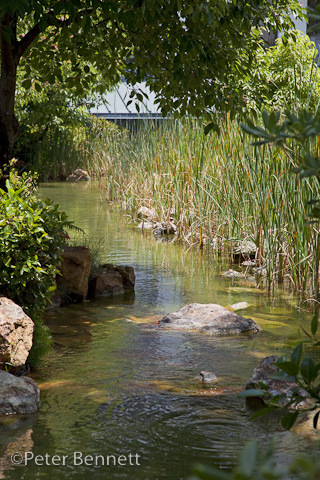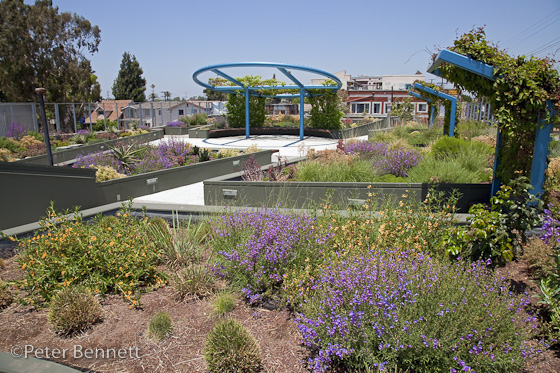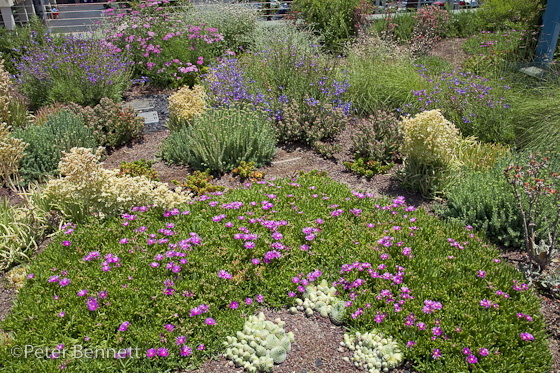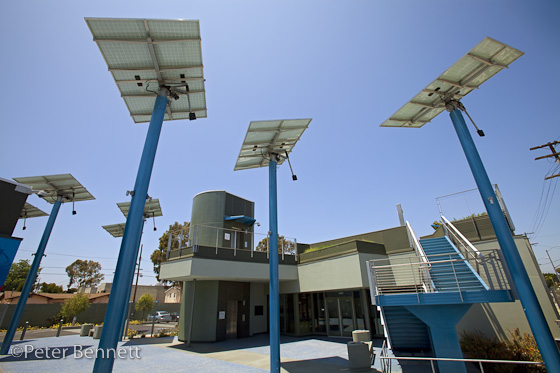Green roofs
I’ve been on vacation a week, but before I left Los Angeles I shot a couple of green roofs in downtown and South Central. They were two very different kinds of green roofs, one a Japanese Garden, the other an environmentally designed sustainable roof for city councilmember Jan Perry’s local headquarters. The Japanese Garden on the third floor of the Kyoto Grand Hotel in Little Tokyo is a half-acre of waterfalls and bamboo shaded alcoves, and even has a little stream running through it. And while it is pretty to look at and may even keep the building a bit cooler, the sustainability factor is pretty low as one can only wonder how much energy is used to keep the waterfall and stream constantly flowing. Still if you want to see the novelty of a manicured Japanese rooftop garden with the Los Angeles skyline behind it, take the elevator to the third floor of the hotel, which is located on the corner of Los Angeles Street and 2nd st, and take a little stroll.
Driving south from there along South Central Avenue, you come across a striking looking building, and a stark contrast to the rest of the neighborhood it resides in. It is Council District 9 Neighborhood City Hall, the offices for councilwoman Jan Perry. Designed by architect Paul Murdoch, the Leed certified building features a drought tolerant rooftop garden that helps mitigate storm runoff and reduces greenhouse gas emissions. A 7,000 gallon underground cistern also collects rainwater for re-usable irrigation. The courtyard contains eight raised photovoltaic arrays that move during the day to track the sun while shading the space below, and also contains more drought tolerant plants around the perimeter of the gated compound that takes up the whole block.
As much of a contrast as these two green roofs may be to each other, they are still the exception when you think about all the other urban rooftops out there. This was made even more apparent when last week I was driving through the Berkshires and was surrounded by thousands of acres of rolling hills of green forests and lush valleys. Imagine for a minute if all the flat rooftops in a city like New York or Los Angeles were converted to green roofs. What would that look like? Now what if some or even most those green roofs were actually small urban farms growing fresh fruits and vegetables, like the Eagle Street rooftop farm I shot the other day in Greenpoint, Brooklyn. The impact of this would be tremendous: cooler buildings while lessening the urban heat island effect (a metropolitan area which is significantly warmer than its surrounding rural areas); local grown produce would mean a big reduction of the energy needed to transport them otherwise; improved health by eating better, and a beautiful green urban landscape that would have an enormous affect on greenhouse gases and carbon emissions.
Is this possible? Yes, but probably not anytime soon. One of the reasons is I still think we see them as unique anomalies rather than the norm. Obviously a green roof or a solar array is the smartest alternative to the empty spaces that reside on top of most buildings, but we are not used to seeing them or thinking of them in that way. This is starting to change, but a big factor that needs to alter is something I am starting to call the Visual Aesthetic. This is not some innate aesthetic we are born with, rather it is what we get used to and accept as the norm. When this starts to change, and I believe it is, then we can start to make real progress. More about this in the next few weeks.
